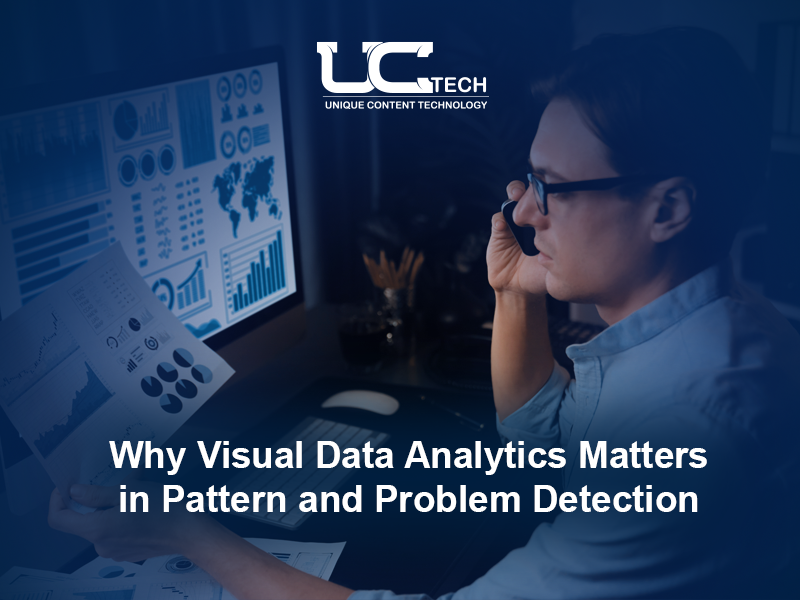Have you ever looked at rows and columns of data and felt overwhelmed, only to realize a chart told the entire story in seconds?
That’s the power of visual data analytics transforming raw numbers into clear, actionable insights.
In today’s competitive landscape, especially across Saudi Arabia’s rapidly transforming business environment, companies can no longer afford to overlook data. Decision-makers need more than just access to data; they need visibility, clarity, and speed. That’s exactly what visual data analytics offers.
Visual vs. Traditional Data Analysis: Key Differences
Traditional data analysis often requires advanced skills to decipher complex datasets. Reports are usually textual or numeric, making it difficult for teams to identify trends or anomalies quickly.
In contrast, visual data analytics presents information through interactive dashboards, graphs, and smart visuals enabling non-technical users to derive insights instantly.
Visual vs. traditional data analysis methods highlight a fundamental shift: from raw data interpretation to intuitive storytelling.
Visual dashboards also facilitate cross-department collaboration, enabling finance, operations, and marketing teams to stay aligned.
How Visualization Simplifies Complex Datasets
Complex enterprise systems produce terabytes of data every day. Using dashboards to identify trends and anomalies allows managers to filter through the noise and focus on what matters.
Imagine a hospital in Riyadh analyzing patient admission trends. Instead of sifting through spreadsheets, visual heat maps and time series charts could immediately highlight unusual admission spikes linked to seasonal illnesses.
Benefits of data visualization in pattern detection include:
- Faster detection of process inefficiencies
- Immediate understanding of KPIs
- Better forecasting using historical trends
- Enhanced team communication and collaboration
Real-World Use Cases: Spotting Patterns and Operational Issues
Saudi Arabia’s Vision 2030 has accelerated digital transformation across sectors. Many organizations are investing in enterprise data analytics services and AI solutions for businesses to stay competitive.
Take the example of a logistics company in Dammam using Power BI and Tableau for interactive business insights.
By deploying a dashboard showing delivery times, driver performance, and route delays, they uncovered a bottleneck in one shipping route.
That insight allowed them to reroute shipments and reduce delivery time by 15%.
In the financial sector, identifying hidden patterns through data visualization helps spot fraudulent activity, optimize portfolios, and improve customer service.
Banks and fintech firms use real-time data visualization in decision-making to detect suspicious behavior and act instantly.
How Visual Tools Improve Team Performance and Decisions
Leadership teams rely on graphical reporting tools for performance monitoring to keep operations on track. Visual analytics provides context, comparison, and clarity—leading to smarter, faster decisions.
Key decision-makers in Saudi ministries are also leveraging data storytelling with smart charts and visuals to present complex reports to stakeholders in an easily digestible format.
When backed by AI applications in Saudi Arabia, visual analytics can even predict future scenarios, helping executives prepare for potential challenges.
For example, predictive analytics for business decisions may indicate the likelihood of inventory shortages or equipment failures.
Read about: Predictive vs. Analytical AI: What’s the Difference?
Top Visualization Platforms Used in Saudi Organizations
Several top data analytics tools are making significant impacts in Saudi organizations, especially in sectors like healthcare, finance, logistics, and government.
- Power BI: Popular for its seamless integration with Microsoft tools and cost-effective enterprise features.
- Tableau: Known for its powerful visualization capabilities and customizability, making it ideal for large datasets.
- Qlik Sense: Offers associative data modeling and real-time updates, useful for dynamic enterprise environments.
When it comes to Power BI vs. Tableau for interactive business insights, Power BI often appeals to SMEs for its affordability and simplicity, while Tableau is favored by larger enterprises for deeper analytics and design flexibility.
Cloud-based deployment is also growing, with many firms adopting cloud-based analytics solutions in Saudi Arabia to enable remote access, scalability, and improved security.
For Saudi enterprises striving to become smarter, faster, and more customer-centric, visual tools provide the competitive edge needed to thrive.
At UCtech for Information Technology, we offer enterprise data analytics services tailored for Saudi businesses looking to leverage the power of visuals, AI, and smart reporting.
FAQ
What industries benefit most from visual analytics?
Is it necessary to hire a data science team to use visual tools?
How do visual analytics support executive leadership?
Are these tools part of digital transformation strategies?

